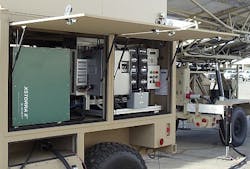Navy to field-test hydrogen fuel cell- and solar-powered military renewable energy system
CHINA LAKE NAVAL AIR WEAPONS STATION, Calif., 1 March 2013.Military renewable energy experts in the U.S. Navy are testing a trailer-mounted regenerative fuel cell system that could save money and warfighter lives, Navy officials say.
The Naval Air Warfare Center Weapons Division at China Lake Naval Air Weapons Station in Ridgecrest, Calif., are evaluating a system that consists of a fuel cell and an array of solar panels that can be towed behind ground vehicles and generate about 5,000 Watts of electricity.
The fuel cell is an energy producing device that takes hydrogen in as its fuel, and through an electrochemical reaction, makes electricity. The only by-product of the process is water and heat. Electrolysis, running a current through water, produces hydrogen and oxygen. This system stores the hydrogen and then feeds it back into the fuel cell.
“Fuel cells are not a new idea, but this system is one-of-a-kind in that all it needs to run is water and sunshine, then it powers itself,” says Matt Malone, an electronics engineer in the Naval Air Warfare Center Weapons Division Renewable Energy Office. “It is completely environmentally friendly and all of the fuel cell parts are recyclable. The system uses the water that it produces to refuel itself.”
Users of the system would pour in water and point the solar arrays at the sun. Through the solar panels the sun generates electricity, which flows into the water to produce hydrogen and oxygen. The oxygen vents into the atmosphere and the hydrogen is stored.
During the day, command centers and other military energy users would be powered by solar energy and excess energy would be used to generate hydrogen. At night, the stored hydrogen would be sent through the fuel cell to create electricity.
China Lake Naval Air Weapons Station is a particularly good place to test solar energy. The base is in the high Mojave desert, and has cloudy days only rarely.
“The only by-products are water, which goes into a tank for use the next day, and heat.” Malone says. “What you don’t have in this scenario is diesel fuel, battery storage, and toxic emissions into the air.”
Malone and the Renewable Energy team wrote the requirements for the system and coordinated with a contractor that produced the hardware. The team will test and evaluate the system in a lab at China Lake before sending it out with troops for field testing.
“Since this system only needs water to operate, one of its biggest benefits is reducing the logistics requirements associated with fuel convoys, which could save lives,” says Wayne Taylor, program manager for the Renewable Energy Office.
For more information contact the Naval Air Warfare Center Weapons Division China Lake at www.navair.navy.mil/nawcwd.

